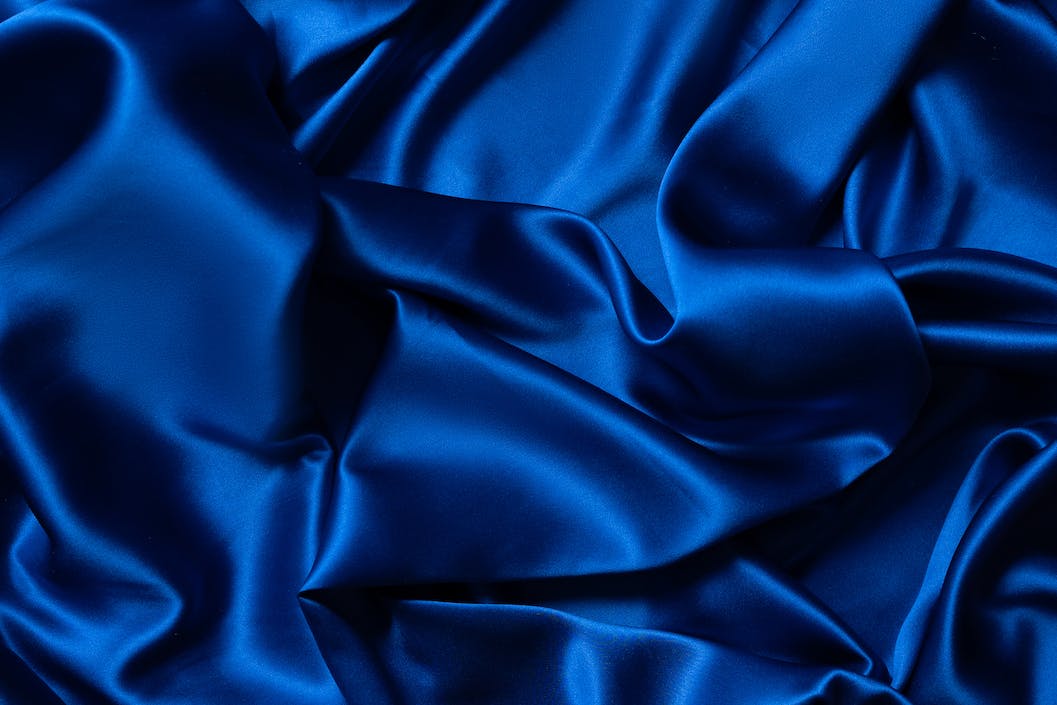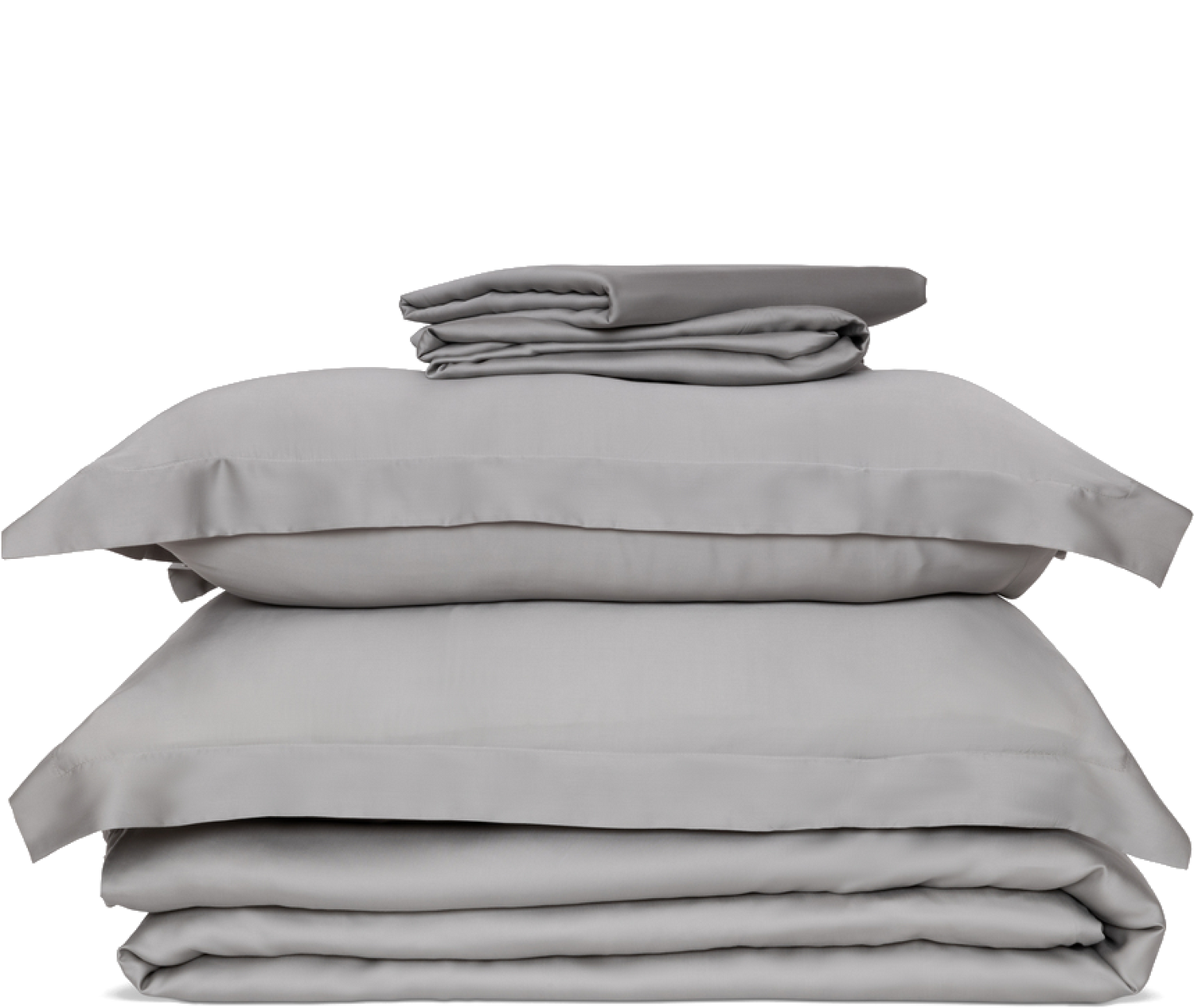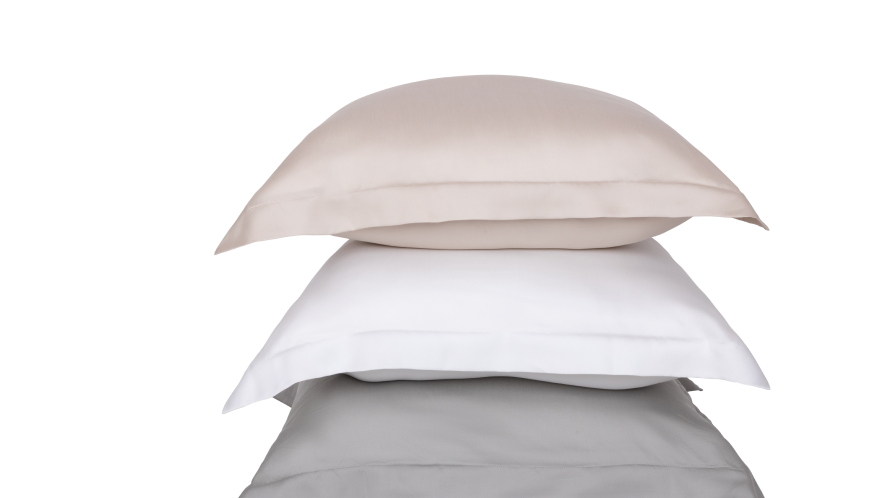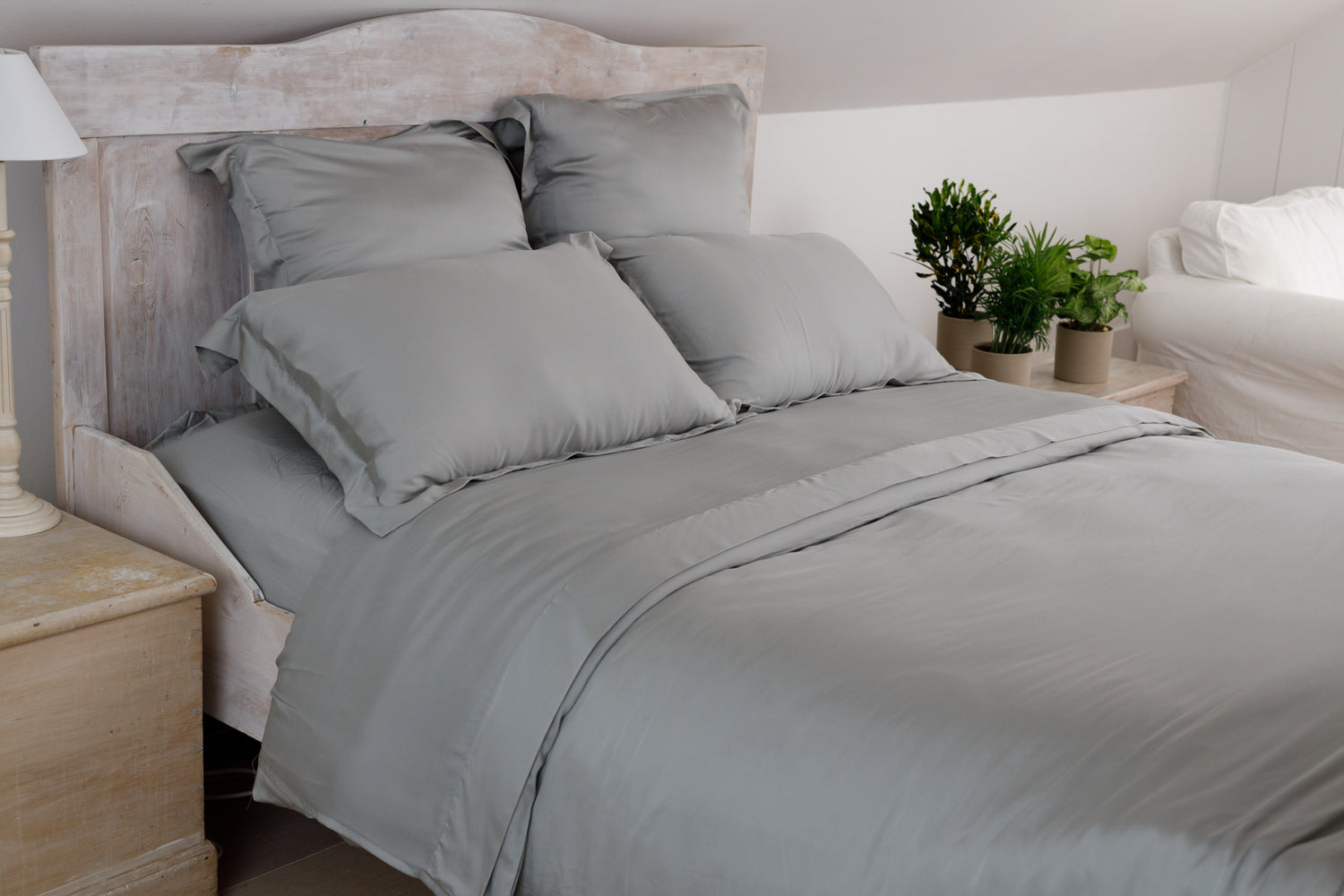If you’re considering buying new bedding, the chances are you’ve come across silk and satin, with both being luxurious, high-quality, and comfortable picks. However, while you’d be forgiven for believing they’re pretty much the same thing, there are a series of contrasts. In this guide, we’ve explored the differences between silk and satin pillowcases, and identified the factors you should consider when choosing new bedding.
How to identify satin and silk pillowcases
Before we delve into the differences between satin vs silk pillowcases, and the advantages and drawbacks of each, it’s first important to be able to identify one from the other.
What are silk pillowcases?
Silk is a naturally-occurring luxury fibre, harvested from the cocoons of sleeping silkworms. Smooth and soft, silk has long-retained its reputation as a high-quality and precious textile, thanks to the extreme comfort it offers, whether used for clothes, pillowcases, or other bedding items.
However, traditional silk isn’t the only form available. Because it’s not often farmed in an ethical fashion, with the process usually involving boiling silkworms alive in their cocoons, there’s a growing popularity around ‘eucalyptus silk’, which offers the same properties while being sourced from the fast-growing, ethical, and sustainable eucalyptus plant.
What are satin pillowcases?
Similar to silk, satin pillowcases exhibit a near-identical smooth glossiness. However, unlike silk pillowcases, which are made from natural materials, satin is often made from a blend of fibres, including synthetic polyester, which typically makes it cheaper to manufacturer and buy.
How can you tell silk from satin?
While boasting a number of similar properties, there are a series of ways to distinguish silk pillowcases from satin:
-
Breathability
Silk or eucalyptus silk fibres are naturally breathable, temperature regulating, and moisture wicking, making them the ideal choice if you’re looking for a cooling bedroom addition. In contrast, because satin typically includes synthetic fibres, it’s not quite as breathable or cooling, which can result in overheating and night sweats.
2. Maintenance and care
When it comes to maintenance, both silk and satin pillowcases are guilty of requiring significant care compared to cheaper textiles. However, of the two, satin is a little trickier to look after. While silk can be washed on a cold, gentle setting (albeit in a protective mesh bag), satin is often hand-wash only to preserve its delicate weave.
3. Texture
While both fabrics are similarly soft to touch, there is a slight difference in feel and texture between silk and satin pillowcases. If you’re unsure as to whether a piece of fabric is one or the other, a simple test is to rub an area between your fingers – if there’s any roughness at all, you’re likely holding satin as opposed to silk.
4. Appearance
Another way to tell the difference between silk vs satin pillowcases is the appearance. While silk will offer a pearlescent finish, satin will often have a genuine shine.
5. Durability
You’ll often find that silk pillowcases last quite a bit longer than satin equivalents – again, because it’s a naturally-occurring fibre with inherent strength. In fact, high quality silk pillowcases, if treated correctly, could last up to ten years.
6. Price
Of course, cost is an enormous factor in just about every purchase decision, so it’s important to consider price when comparing satin vs silk bedding. Side-by-side, satin is the more affordable material of the two. However, because of silk’s long-lasting durability and temperature-regulating breathability, it remains a popular and effective long-term investment.
The pros and cons of silk pillowcases
Below, we’ve outlined the benefits and drawbacks of silk pillowcases, to help you make an informed buying decision.
The benefits of silk pillowcases
There are plenty of reasons to choose silk pillowcases, including:
Hypoallergenic
Something you might not have known about silk is that it’s naturally hypoallergenic, meaning you can say goodnight to dust, mites, and mould.
As well as protecting you against existing skin and respiratory conditions (i.e. eczema and asthma), sleeping on silk reduces the risk of bed-based allergens triggering dormant reactions.
Breathable
As a natural fabric, silk is highly breathable, allowing air to constantly flow through the fibres. This means that silk bedding remains dry throughout the night, hindering bacterial growth and guaranteeing good hygiene.
Temperature regulating
As well as being exceptionally breathable, silk pillowcases are naturally heat regulating, which keeps your head a comfortable temperature - whether it’s the depths of winter or heights of summer.
Healthy for hair and beauty
Thanks to its hypoallergenic, temperature regulating, and breathable properties, silk pillowcases rank among the best for skin and hair care. Combine this with the soft, friction-free feel, which puts a stop to fussy frizz and nighttime wrinkling, and you’ll soon begin to see the benefits.
Great for sensitive skin
Soft and soothing, silk pillowcases are a great choice for anyone with sensitive skin. Gentle to touch, silky bedding keeps you cool and combats allergens, to prevent acne and other dermatological conditions from reaping havoc.

Relax On Our Organic Eucalyptus Silk Pillows & Pillowcases | Shop Here
The disadvantages of silk pillowcases
Just as it’s useful to know the benefits, it’s important to understand the disadvantages of silk bedding too:
Unethical manufacturing process
If you’re looking for an ethically-sourced bedding fabric, then unfortunately traditional silk probably isn’t for you. To produce classic silk, manufacturers boil silk worms alive in their cocoons, before extracting the silk and weaving it into fibres. What’s more: it can take up to 2,500 silk worms to produce just a single pound of fabric.
However, there are a couple of alternatives:
- If you’re happy with a slightly inferior-quality product, you can choose organic silk, which is extracted after the silk worms have emerged.
- For a high-quality, luxurious product that mirrors the real thing, eucalyptus silk might be your best bet.
Can be expensive
As a result of being such a high-quality, in demand, and luxurious fabric, silk pillowcases are known to rank among the most expensive. However, given its long-lasting durability and extensive list of benefits, silk is often considered to be a worthwhile investment.
Fades in sunlight
One of the downsides of silk is that it will begin to fade when exposed to sunlight or direct heat, meaning you should avoid drying your pillowcases outside (which can be tempting in the summer months). Instead, wash on a low temperature cycle, and air dry your silk bedding indoors.
Can be slippery
One of silk’s main benefits is that it’s luxuriously smooth and soothing; however, this can also be one of its main drawbacks. Because silk is so slippery and frictionless, you might find that your pillow breaks free of its case from time to time.
The pros and cons of satin pillowcases
Similarly, as above, we’ve also outlined the pros and cons of satin pillowcases, to help you decide whether this fabric is the right fit for your bedroom.
The benefits of satin pillowcases
Read on to explore the main benefits of satin pillowcases, including the reasons you might choose satin vs other bedding textiles.
Affordability
One prominent advantage that satin has over silk is affordability. However, that’s not to say satin is at the cheap end of the market; in fact, while more competitively priced than silk, it’s still much more expensive than classic cotton and even linen.
Smooth and silky
Luxuriously smooth, satin is very similar to silk in both its appearance and feel, with a comfortable aesthetic that makes every bed a dreamy paradise. Of course, if you were to inspect both side by side, you’d probably notice a slightly rougher finish to the satin, though it’s not something that’s likely to bother you in the long run.
Reduces hair frizz
Boasting many of the same benefits as silk, satin is another fabric that can help to prevent a frizzy bed-head, with the slippery texture allowing your head and hair to move freely through the night without friction causing a fuss.
The disadvantages of satin pillowcases
Finally, it’s time to observe the disadvantages of satin pillowcases, to give you the full picture and help you decide whether to opt for silk, satin, or something else entirely.
Night sweats
Because satin doesn’t offer the same level of breathability and temperature regulation as silk, it’s not quite as good at keeping you cool and comfortable all year round. Because of the synthetic fibres woven into the fabric, you might start to experience night sweats, even if you’re not particularly prone to overheating.
Not as soft as silk
We’ve touched on it briefly above, but, when put under scrutiny, satin simply isn’t as soft and soothing as silk. That’s not to say it’s not a luxurious and high-quality option; it just means when paired, you’d likely notice one to be silkier than the other.
Care and maintenance
Satin is a relatively fussy fabric and can be quite tricky to care for and look after. For example, many satin pillowcases include instructions to hand wash only, meaning you’re advised against putting them in a washing machine – even on a low temperature cycle. Some satin bedding is even dry clean only!
With that final point, you should now feel confident about choosing between satin and silk pillowcases! If you’re feeling inspired, explore our selection of bestselling eucalyptus silk bedding, or discover even more useful insight and guides from our experts over on the Ethical Bedding blog.
FAQs
If you’re still unsure about which bedding type to choose for your home, we’ve answered some of our most frequently asked customer questions below.
Is satin or silk more sustainable?
If sustainability is something you’re passionate about, then you might want to consider eucalyptus silk as opposed to satin or traditional silk. Manufactured from the quick-growing and renewable eucalyptus plant, the fabric is growing in popularity thanks to its pro-planet footprint. What’s more, its long list of benefits matches and even outperforms the real thing.
Read our guide to sustainable bedding for more information.
Is silk or satin best for sensitive skin?
While silk and satin are both exceptionally soft and soothing, silk is the better of the two if you suffer from sensitive skin. This is because silk is made entirely of naturally occurring materials, whereas satin often includes rougher, synthetic fibres.
For more information, discover six ways silk pillowcases are good for your skin.
Can cotton be a good alternative to satin or silk?
Cotton has long-been a popular bedding choice, thanks to its versatility and wide range of options to suit all budgets. However, there are few types of cotton options that can rival silk or eucalyptus silk – Egyptian cotton comes the closest, but even this often falls short in the comfort department.
If you’re interested in learning more, read our guide on eucalyptus silk vs cotton bedding.








